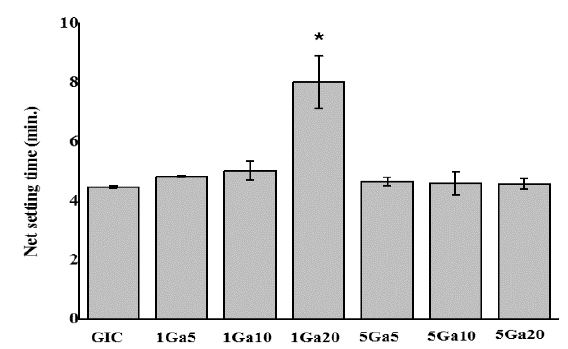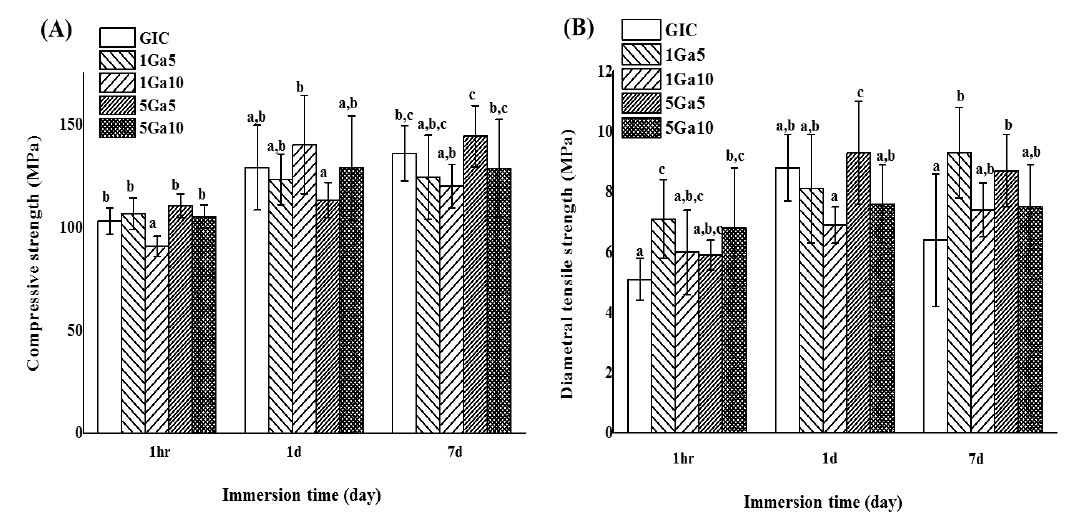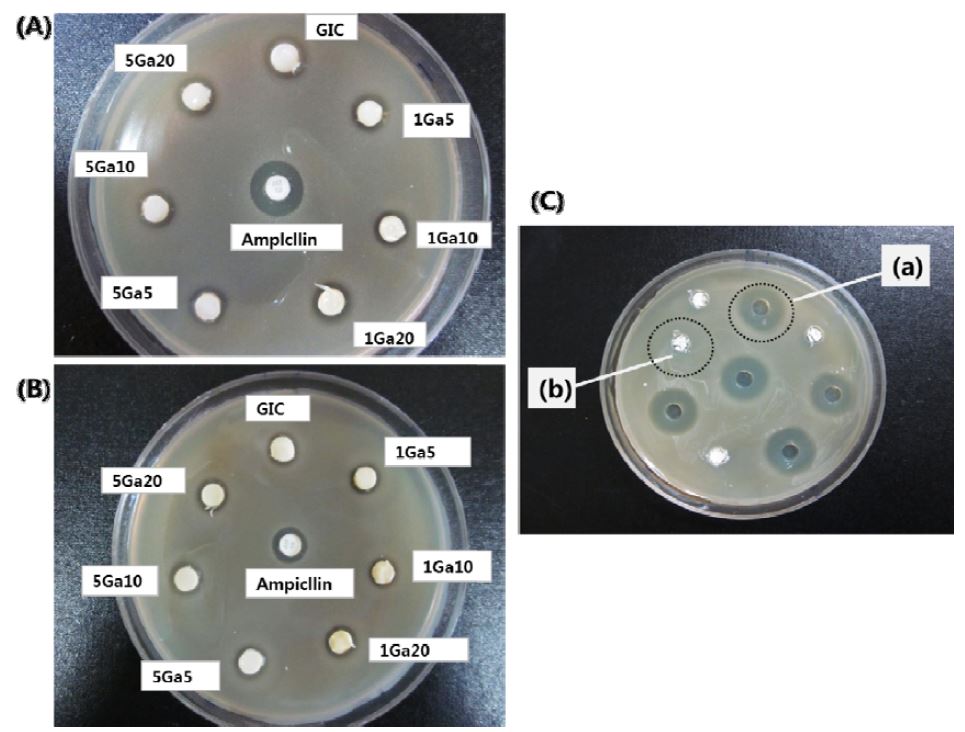
Gallium phosphate glass (GPG)를 첨가한 글라스아이오노머 시멘트의 기계적 성질과 항균효과
초록
본 연구는 1 및 5 mol% gallium phosphate glass (GPG)분말을 함유한 글라스아이오노머시멘트(GIC)를 제조하고 기계적 특성과 항균성을 평가하고자 하였다. GPG 분말을 GIC분말에 0~20 wt% 혼합하고 순경화시간을 측정하였으며 압축강도(4 mmØ×6 mm)와 간접인장강도(6 mmØ×4 mm) 시편을 제작 후 37℃ 수중에서 1 h, 24 h, 7 d 보관 후 평가하였다. 이들 시멘트의 항균성은 S. mutans와 S. sobrinus 균주를 대상으로 아가디스크 확산법을 이용하여 평가하였다. 결과는 일원배치 분산분석과 Tukey HSD 사후검정으로 실시하였다(p<;0.05). 실험결과 압축강도는 전반적으로 대조군 및 실험군에서 유의한 차이를 나타내지 않았으며 간접인장강도는 유의한 증가를 보였다. 1 mol% GPG-GIC는 S. mutans에 대해서 통계적 차이는 나타나지 않았으나, 항균성의 증가 경향을 보였다. 이 결과들은 GPG를 첨가한 GIC는 항균효과와 기계적 성질 향상을 위한 잠재성이 있음을 나타내었다.
Abstract
This study investigated the mechanical properties and antibacterial activity of glass ionomer cement (GIC) containing 1 mol% or 5 mol% gallium phosphate glass (GPG) powder. GPG were added to conventional GIC powder in a range of 0~20 wt%. The specimens for compressive strength (4 mmØ×6 mm) and diametral tensile strength (6 mmØ×4 mm) were prepared by mixing with the cement liquid and kept in an water of 37±1℃. Mechanical properties were evaluated at an interval of 1 h, 24 h, and 7 days. Antibacterial activity of specimens against to S. mutans and S. sobrinus was evaluated using agar diffusion methods. Data were statistically analyzed by one-way ANOVA and Tukey HSD post-hoc test (p<0.05). Diametral tensile strength of GIC containing GPG were significantly higher than control GIC while compressive strength showed no statistical difference. There was an increasing tendency of antibacterial activity for GPG-GICs. Results indicated that GPG can be considered as potential reinforcing agent for increasing antibacterial and mechanical properties for conventional GIC.
Keywords:
Gallium phosphate-based glass (GPG), Glass ionomer cement, Compressive strength, Diametral tensile strength, Antibacterial activity키워드:
향균성, 압축강도, 간접인장강도, Gallium phosphate-based glass (GPG), 글라스아이오노머시멘트(GIC)서 론
1970년대 개발된 치과용 글라스아이오노머 시멘트(glass ionomer cement; GIC)는 calcum-fluoro-aluminosilicate glass 분말과 폴리아크릴릭산(polyacrylic acid; PAA) 액으로 구성되었으며 혼합 시 산-염기 반응으로 방출되는 카복실기 이온(–COOH)과 치질 Ca2+의 화학적 결합으로 인해 접착강도가 우수할 뿐 아니라 불소 방출에 의한 항우식 효과와 생체친화성이 높은 재료로 치과진료에서 가장 많이 사용되고 있는 재료의 하나이다(1, 2). 그러나 이러한 장점에도 불구하고 GIC는 높은 취성과 낮은 강도 및 마모 저항성으로 인해 높은 교합력이 가해지는 부위에서의 사용을 제한하고 있다(3-5). 따라서 취약한 GIC의 성질을 개선하기 위해 무.유기물 등 다양한 재료를 첨가하여 물성과 조성 변화에 대한 연구가 보고되었다. 금속입자를 첨가하여 글라스아이오노머 시멘트의 분말 입자간의 결합을 증진 시켰으며(6), 스테인레스강 및 티타늄 분말 등 금속입자로 강화한 기계적 특성 및 생체적합성에 관한 연구를 보고하였고(7-10), 시멘트의 경조직 재생능을 위해 수산화인회석, 나노 생체활성유리 입자 등을 첨가한 연구도 이루어졌다(11-13). 이후에도 탄소나노튜브(carbon nanotubes), 키토산 등 다양한 재료를 첨가하여 기계적 특성이 개선됨을 입증하였다(14-16). 또한 글라스 성분에 지르코니아를 첨가하거나(17), GIC에서 유리되는 Al3+이온의 위해성을 배제한 Al-free GIC 등도 개발되었다(18, 19).
한편으로 GIC의 또 다른 문제점도 보고되고 있다. 비록 GIC가 불소를 방출하고 항균효과도 발휘할 것으로 기대되지만, 치아 인접면에서의 방출 농도는 S. mutans와 같은 세균들의 축적을 저지할 정도의 충분한 농도가 아니라고 보고 하였으며(20), 접착력이 우수한 재료임에도 불구하고 미세누출로 인한 세균의 침입으로 이차우식이 발생한다고 하였다(21, 22). 이에 따라 GIC의 효과적인 항균력의 필요성이 제시되었으며 이를 위하여 클로르헥시딘, 나노입자, 생체재료 등 다양한 첨가 방법을 통한 연구가 선행되었으나 지속적인 항우식 효과가 미흡하였고, 물리적, 기계적 성질이 저하되었다(23, 24). 따라서 GIC에 함유되어 보다 지속적인 항균 효과를 발휘하고 기계적 특성도 강화하는 물질을 함유하는 GIC의 개발이 필요하다.
최근 Ca-Na-P-Ga 4성분계 gallium-doped phosphate-based glasses (GPG)를 합성하고 여기에서 유리된 Ga3+ 이온들이 S. mutans를 비롯한 각종 세균에 대하여 항균효과가 있음이 밝혀졌다(25-28). 이는 세균의 대사에 필요한 Fe3+ 이온들이 직경이 비슷한 Ga3+ 이온들에 의하여 치환되어 일종의 트로이 목마 작용으로 세균의 대사작용을 방해하는 항균 작용에 의한 것으로 다양한 병원성 세균에 항균 효과가 있음을 입증한 것이다. 이에 본 연구는 GPG를 치과용 GIC에 첨가함으로써 기계적 특성과 항균효과에 미치는 영향에 대해 알아보고자 한다.
재료 및 방법
1. 실험 재료
본 연구에서는 선행연구에서 합성한 Ga2O3 1 mol% (1GPG)와 5 mol% (5GPG) GPG를 제공받아 사용하였으며 이들의 조성은 Table 1에 소개하였다(27). 이 글라스들의 분말은 마노사발에서 분쇄하고 체를 사용하여 45 μm 이하로 만들었다. GIC분말로는 상용 GIC (HY-BOND Glassio-nomer CX, Shofu. Japan)를 사용하였고, GPG를 첨가하여 지르코니아 볼을 사용한 24시간 볼밀(ball mill) 혼합으로 0~20 wt%의 복합 분말을 제조하였다. Table 2에는 본 연구에서 혼합한 GPG함유 GIC의 조성과 기호를 표시하였다
혼합분말은 GIC 액과 제조사의 지시대로 혼합한 후 순경화시간을 측정하였다. 순경화시간은 ISO 9917(29)에 따라 혼합한 시멘트를 몰드 내에 채운 다음 (37±1)℃ 상대습도 100% 항온수조에서 무게(400±5)g, 침의 끝 부분 직경(1±0.1)mm의 원통형 압자를 이용하여 침의 압흔이 완전한 원형을 형성하지 못할 때까지의 시간으로 측정하였다. 각 군별로 세 번 반복 측정하여 시멘트의 순경화시간을 결정하였다.
기계적 특성 평가를 위하여 0~10 wt% GPG-GIC 복합 시멘트를 압축강도와 간접인장강도를 평가하였다. 시편은 각 실험군당 10개의 시편을 제작하였으며, 분말과 액은 제조사의 지시대로 2:1 비율로 혼합하여 분리형 금속몰드에 주입한 다음 ISO 규격 9917에 따라 (37±1)℃, 상대습도 100% 조건에 1시간 보관 후 시편을 제거한 후 37℃ 증류수에 보관하였다.
압축강도(σCS)는 직경 4 mm, 높이 6 mm의 실린더 주형의 금속 몰드를 이용하였으며 다음 공식에 의하여 산출하였다.
여기서 P는 파절 시 최대하중, r은 시편의 반경임.
간접인장강도(σDTS)는 직경 6 mm, 높이 4 mm의 시편을 사용하였으며 다음 공식에 의하여 산출하였다.
여기서 P는 압축하중, D는 시편의 직경, T는 높이를 나타낸다.
제작된 시편은 1시간, 1일, 7일 보관한 후 재료시험기(Instron 8871, Instron 3344, Norwood, MA, USA)를 이용하여 분당 1 mm/min의 속도로 강도를 측정하였다.
2. 항균 시험
본 실험에 사용한 균주는 조선대학교에서 제공받은 S. mutans (ATCC 25175)와 S. sobrnius (ATCC 33478)를 사용하였으며, 멸균한 Brain Heart Infusion (BHI, Difco laboratories, Dickinson, USA)배지에서 배양하였다.
항균실험 평가는 1 mol% 및 5 mol% GPG를 0~20 wt% 혼합하여 GPG/GIC 복합 시멘트를 아가 디스크 확산법(agar disk diffusion method)으로 평가하였다. 멸균 처리한 BHI 배지에 S. mutans (ATCC 25175)와 S. sobrnius (ATCC 33478)를 37℃ CO2 incubator에서 18시간 배양한 후 spectrophotometer (UV1101 Biotech, Manufacture WPA) 595 nm에서 OD값 0.5농도를 맞춰 평판배지(Ø 15 mm)에 멸균된 면봉을 이용하여 균일하게 도말하였다. 세균 증식의 억제대가 겹치지 않도록 각각의 배지 내부를 유리관을 이용하여 Ø 5 mm, 깊이 2 mm을 천공하였다. 여기에 제조된 분말과 액은 제조사의 지시대로 2:1 비율로 혼합하여 멸균 syringe에 담아 천공된 내부를 채운 다음 37℃ 배양기에서 18시간 배양 후 시편을 포함하여 항균성이 나타난 영역의 직경(DIZ, diameter of antibacterial inhibition zone, mm)을 디지털 캘리퍼스(Digimatic, CD-S15C, Mitutoyo, Japan)로 3방향에서 측정하여 각 군별 억제대의 평균값으로 나타냈다(n=5).
3. 통계분석
각 실험군의 강도는 PASW Statistics (SPSS, Chicago, IL, USA)을 사용하여 일원배치(one-way ANOVA)와 Tukey HSD 다중비교 분석을 사후검정으로 실험군간 비교 평가하였다(P<0.05).
결 과
1. 순경화시간(Net setting time)
각각 GPG를 첨가한 GIC 경화실험 결과 4.5~8.0분으로 측정되었다(Figure 1). 1Ga20실험군에서 유의하게 8분으로 증가하였으나 다른 실험군에서는 4.5~5.0분의 범위를 보였다.
2. 기계적 특성
GPG를 첨가한 GIC의 압축강도와 간접인장강도의 실험결과는 Figure 2에 나타내었다. 압축강도는 대조군 102.9-135.9 MPa 범위, 실험군에서는 105.1~144.1 MPa 범위를 보였다. 모든 실험군의 1시간 초기강도에서는 유의성이 나타나지 않았으며 오히려 1Ga10의 평균 압축강도는 약간 감소하였다. 그러나 1일 침전 후 1Ga10 군의 압축강도는 140 MPa로 상승하였으며, 7일 침전 후 5Ga5는 144 MPa로 나타났으나 전반적으로 대조군 및 타군과 유의한 차이를 보이지 못하였다 (p<0.05). 그러나 GIC-GPG군들의 간접인장강도는 초기에(1 h) 유의하게 상승하였으며, 14일 경과 후에도 1Ga5 및 5Ga5군은 유의하게 증가하였다.
3. 항균 효과
GPG-GIC 복합 시멘트의 아가 디스크 확산 실험 결과는 Table 3과 Figure 3에 나타내었다. S. mutans 균에 대하여 1GPG 분말 자체는 용해되며 21 mm의 큰 DIZ 값을 나타냈다. 그러나 5GPG는 항균성이 거의 나타나지 않았다. 전체적으로 시편의 크기를 포함하여 9~11 mm의 DIZ 값을 보였으며 실험군간 통계적 차이는 나타나지 않았다. 또한 대조군인 ampicillin 디스크 시편의 항균억제 보다 작은 값을 나타내었다. 시멘트 대조군인 GIC 자체도 9~10 mm의 DIZ 값을 나타냈다.

Results of DAIZ (diameter of antibacterial inhibition zone) by agar diffusion test for S. mutans and S. sobrinus. DAIZ values include the specimen diameter (~5 mm)(n=5).
고 찰
치과용 시멘트는 구강 내 수복물의 합착, 고정, 와동 충전/베이스용 등 다양한 분야에 사용되지만 수복 후 타액으로 용해되어 미세누출과 세균 부착 증가로 인해 물리적 성질 감소와 이차 치아우식증 질환이 발생하게 된다. GIC는 수복물로도 사용되고 있으며 가장 큰 실패 원인은 2차 우식이다. GIC재료는 불소를 유출시켜 치아 경조직의 재석화뿐 아니라 세균 수를 억제하는 것으로 알려져 있으나, 임상에서 수복으로 인한 이차우식 발생의 억제는 역부족이다(30, 31). 따라서 그간 기계적 성질과 항균성이 있는 GIC 개발을 위하여 많은 연구들이 있었다.
GIC의 항균력을 높이기 위하여 첨가물질로 가장 많이 연구해온 것은 여러 가지 형태의 chlorhexidine이다. 이들은 주로 1-5%의 chlorhexidine diacetate (CHX)을 종래의 GIC 또는 레진 첨가 GIC 분말에 첨가하여 최대 60일까지 S. mutans균에 대하여 in vitro 항균력을 얻었다(32-34). 그러나 5% 이상의 CHX 첨가는 시멘트의 기계적 성질을 감소시키는 단점이 지적되어 왔다. 이외에 Epigallocatechin-3- gallate (EGCG), Poly(quaternary ammonium salt) (PQAS), Furanone, Triclosan, nano silver/TiO2 분말 등 유기 또는 무기물질을 첨가하는 연구가 활발하게 진행되어 왔다(35).
그러나 GIC 파우더는 글라스 분말이므로 항균성을 지니며 분말의 재료와 같은 유형의 글라스 분말의 첨가는 유기재료에 비하여 시멘트화에 매우 유리할 것으로 기대된다. 이에 본 연구는 물리적 성질과 항균 효과가 입증된 Gallium phosphate glass (GPG)를 GIC에 첨가하여 기계적 성질과 항균효과를 향상하고자 하였다. 제조한 복합 GIC의 경화시간은 4.5~8.0분이었으며 1 mol% GPG를 20 wt% 첨가한 1GPG20실험군에서 8.0분으로 증가하였다. 이는 방출된 Ga2+이온이 GIC의 –COOH이온과의 결합 저하가 원인이라 여겨진다. 그러나 전체적으로 ISO규격 9917에 제시한 2-8분 허용 범위 내에 포함된다(Figure 1). 한편 5GPG 함유 시멘트에서 이러한 현상이 나타나지 않은 것은 5GPG의 낮은 용해성 때문인것으로 사료되나 좀더 분석이 필요하다.
GPG 첨가 GIC의 압축강도는 전체적으로 비첨가 GIC의 그것과 유의한 차이를 나타내지 못하였으나 간접인장강도는 유의하게 높은 값을 보였다. 이는 시간이 경과하면서 GPG와 시멘트 기질과 강하게 결합된 것이라 여겨진다. 결과적으로 GIC에 10% 이내의 GPG의 첨가는 기계적 특성의 저하는 일으키지 않은 것으로 보인다.
구강내에 치아우식증의 대표적 균주는 연쇄상구균 S. mutans와 S. sobrinus라고 볼 수 있다. 본 연구에서는 이들 세균에 대하여 0~20 wt% 첨가의 GPG-GIC의 아가 디스크 확산법에 의하여 항균 작용을 조사하였다. 비록 통계적 유의성은 없으나 GIC에 GPG를 첨가하는 양이 증가할수록 억제대는 증가하는 양상을 보여 항균효과가 있음이 나타났다. 항균성은 항균물질의 성분 유출의 속도 및 양에 영향을 받는다. 그러므로 본 연구에서는 이루어지지 않았으나 제조한 시멘트의 이온 유출량을 조사할 필요가 있다. 이와 함께 보다 긴 시간의 항균성 발현 여부에 대한 실험이 향후 요구된다.
분말 자체에 대한 항균성의 조사에서 1GPG은 아가배지에서 용해되며 명확한 항균성을 나타냈으나, 5GPG는 항균성이 거의 나타나지 않았다. Valappil 등은 1, 3, 5 mol% GPG로 병원성세균을 이용하여 연구한 결과 3, 5mol GPG에 비해 1 mol% GPG의 확산 기능이 현저히 높아 항생제로서의 가능성을 보고하였는데 본 연구에서도 동일한 결과를 보여주었다 (27).
본 연구에서는 GPG를 GIC에 첨가시 기계적 성질과 항균성 증진에 효과가 있으며 새로운 항균 GIC의 소재로 사용 가능성을 입증하였다. 향후 보다 개선된 결과를 위해서는 GPG 분말의 조성 변화 및 다양한 세균과 항균성의 지속성에 대한 연구가 진행되어야 할 것으로 사료된다.
Acknowledgments
본 연구는 과기정통부 이공분야기초연구사업의 지원을 받았음(2018R1C1B5043265, 2019R1H1A2039662).
저자들은 GPG를 제공하여주신 UCL Eastman Dental Institute의 JC Knowles 교수와 항균 실험에 사용한 균주를 제공하여주신 조선대학교 치과대학 한국구강미생물자원은행 국중기 교수에게 깊은 감사를 드립니다.
References
-
Wilson AD. A new translucent cement for dentistry: the glass-ionomer cement. Br Dent J. 1972;132:133-5.
[https://doi.org/10.1038/sj.bdj.4802810]

-
Erickson R, Glasspool E. Bonding to tooth structure: A comparison of glass‐ionomer and composite‐resin systems. J Esthet Dent. 1994;6(5):227-44.
[https://doi.org/10.1111/j.1708-8240.1994.tb00864.x]

- Øilo G, Um CM. Bond strength of glass-ionomer cement and composite resin combinations. Quintessence Int. 1992;23(9):633-9.
-
Lohbauer U. Dental glass ionomer cements as permanent filling materials?–properties, limitations and future trends. Materials. 2009;3(1):76-96.
[https://doi.org/10.3390/ma3010076]

-
Hammouda IM. Reinforcement of conventional glass-ionomer restorative material with short glass fibers. J Mech Behav Biomed Mater. 2009;2(1):73-81.
[https://doi.org/10.1016/j.jmbbm.2008.04.002]

- McLean JW, Gasser O. Powdered dental material and process for the preparation thereof. US Patent 4,527,979, 1985.
-
Williams J, Billington R, Pearson G. Silver and fluoride ion release from metal‐reinforced glass‐ionomer filling materials. J Oral Rehabi. 1997;24(5):369-75.
[https://doi.org/10.1046/j.1365-2842.1997.d01-299.x]

-
Kerby R, Bleiholder R. Physical properties of stainless-steel and silver-reinforced glass-ionomer cements. J Dent Res 1991;70(10):1358-61.
[https://doi.org/10.1177/00220345910700100801]

-
Moshaverinia A, Roohpour N, Chee WW, Schricker SR. A review of powder modifications in conventional glass-ionomer dental cements. J Mater Chem 2011;21 (5):1319-28.
[https://doi.org/10.1039/C0JM02309D]

- Kim DA, Kim GR, Song CK, Yoon JW, Lee HH. Strength of dental glass-ionomer cement by addition of titania nanofiber. Kor J Dent Mater 2012;39(3):177-82.
-
Choi JY, Lee HH, Kim HW. Bioactive sol–gel glass added ionomer cement for the regeneration of tooth structure. J Mater Sci: Mater Med. 2008;19(10):3287.
[https://doi.org/10.1007/s10856-008-3464-8]

-
Arita K, Yamamoto A, Shinonaga Y, Harada K, Abe Y, Nakagawa K et al. Hydroxyapatite particle characteristics influence the enhancement of the mechanical and chemical properties of conventional restorative glassionomer cement. Dent Mater J. 2011;30(5):672-83.
[https://doi.org/10.4012/dmj.2011-029]

-
Kim DA, Lee JH, Jun SK, Kim HW, Eltohamy M, Lee HH. Sol–gel-derived bioactive glass nanoparticleincorporated glass ionomer cement with or without chitosan for enhanced mechanical and biomineralization properties. Dent Mater 2017;33(7):805-17.
[https://doi.org/10.1016/j.dental.2017.04.017]

-
Li GY, Wang PM, Zhao X. Mechanical behavior and microstructure of cement composites incorporating surface-treated multi-walled carbon nanotubes. Carbon. 2005;43(6):1239-45.
[https://doi.org/10.1016/j.carbon.2004.12.017]

-
Kim DA KH, Shin US, Lee HH. Effects of carbon nanotube addition on the mechanical properties of dental glassionomer cement. Kor J Dent Mater. 2016;43(1):43-50.
[https://doi.org/10.14815/kjdm.2016.43.1.43]

-
Kim DA, Kim GR, Jun SK, Lee JH, Lee HH. Strengthening of conventional dental glass ionomer cement by addition of chitosan powders with low or high molecular weight. Kor J Dent Mater. 2017;44 (1):69-77.
[https://doi.org/10.14815/kjdm.2017.44.1.069]

-
Abo-Mosallam HA, Kim D-A, Kim H-W, Lee H-H. Influence of ZrO2 oxide on the properties and crystallization of calcium fluoro-alumino-silicate glasses. Ceram Int. 2016;42(4):5107-12.
[https://doi.org/10.1016/j.ceramint.2015.12.028]

-
Kim DA, Abo-Mosallam HA, Lee HY, Kim GR, Kim HW, Lee HH. Development of a novel aluminum-free glass ionomer cement based on magnesium/strontium-silicate glasses. Mater Sci Eng C Mater Biol Appl. 2014;42:665-71.
[https://doi.org/10.1016/j.msec.2014.06.006]

-
Gomes FO, Pires RA, Reis RL. Aluminum-free glass-ionomer bone cements with enhanced bioactivity and biodegradability. Materials Science and Engineering: C. 2013;33(3):1361-70.
[https://doi.org/10.1016/j.msec.2012.12.037]

-
Van Dijken J, Persson S, Sjostrom S. Presence of Streptococcus mutans and lactobacilli in saliva and on enamel, glass ionomer cement, and composite resin surfaces. Euro J Dent Res. 1991;99(1):13-9.
[https://doi.org/10.1111/j.1600-0722.1991.tb01017.x]

- Pachuta S, Meiers J. Dentin surface treatments and glass ionomer microleakage. Am J Dent 1995;8(4): 187-90.
-
Shaw A, Carrick T, McCabe J. Fluoride release from glass-ionomer and compomer restorative materials: 6-month data. J Dent. 1998;26(4):355-9.
[https://doi.org/10.1016/S0300-5712(97)00016-X]

-
Jedrychowski JR, Cauputo AA, Kerper S. Antibacterial and mechanical properties of restorative materials combined with chlorhexidines. J Oral Rehabil 1983;10(5):373-81.
[https://doi.org/10.1111/j.1365-2842.1983.tb00133.x]

-
Anderson P, Bollet Quivogne F, Dowker S, Elliott J. Demineralization in enamel and hydroxyapatite aggregates at increasing ionic strengths. Arch Oral Biol. 2004;49(3):199-207.
[https://doi.org/10.1016/j.archoralbio.2003.10.001]

-
Valappil SP, Coombes M, Wright L, Owens GJ, Lynch RJ, Hope CK et al. Role of gallium and silver from phosphate-based glasses on in vitro dual species oral biofilm models of porphyromonas gingivalis and streptococcus gordonii. Acta Biomater 2012;8(5):1957-65.
[https://doi.org/10.1016/j.actbio.2012.01.017]

-
Wren A, Coughlan A, Placek L, Towler M. Gallium containing glass polyalkenoate anti-cancerous bone cements: glass characterization and physical properties. J Mater Sci Mate Med. 2012;23(8):1823-33.
[https://doi.org/10.1007/s10856-012-4624-4]

-
Valappil SP, Ready D, Neel EAA, Pickup DM, Chrzanowski W, O'Dell LA et al. Antimicrobial Gallium-Doped Phosphate-Based Glasses. Adv Funct Mater. 2008;18(5):732-41.
[https://doi.org/10.1002/adfm.200700931]

-
Sahdev R, Ansari TI, Higham SM, Valappil SP. Potential use of gallium-doped phosphate-based glass material for periodontitis treatment. J Biomater Appl. 2015;30 (1):85-92.
[https://doi.org/10.1177/0885328215571952]

-
Benelli EM, Serra MC, Rodrigues JAL, Cury JA. In situ Anticariogenic Potential of Glass lonomer Cement. Caries Res. 1993;27(4):280-4.
[https://doi.org/10.1159/000261551]

-
Forss H, Widström E. Reasons for restorative therapy and the longevity of restorations in adults. Acta Odontol Scand. 2004;62(2):82-6.
[https://doi.org/10.1080/00016350310008733]

-
Sanders BJ, Gregory RL, Moore K, Avery DR. Antibacterial and physical properties of resin modified glass-ionomers combined with chlorhexidine. J Oral Rehabil. 2002;29(6):553-8.
[https://doi.org/10.1046/j.1365-2842.2002.00876.x]

-
Hoszek A, Ericson D. In vitro fluoride release and the antibacterial effect of glass ionomers containing chlorhexidine gluconate. Oper Dent. 2008;33(6):696-701.
[https://doi.org/10.2341/08-20]

-
Tuzuner T, Kusgoz A, Er K, Tasdemir T, Buruk K, Kemer B. Antibacterial activity and physical properties of conventional glass-ionomer cements containing chlorhexidine diacetate/cetrimide mixtures. J Esthet Restor Dent. 2011;23(1):46-55.
[https://doi.org/10.1111/j.1708-8240.2010.00385.x]

-
Hafshejani TM, Zamanian A, Venugopal JR, Rezvani Z, Sefat F, Saeb MR et al. Antibacterial glass-ionomer cement restorative materials: A critical review on the current status of extended release formulations. J Control Release. 2017;262:317-28.
[https://doi.org/10.1016/j.jconrel.2017.07.041]




